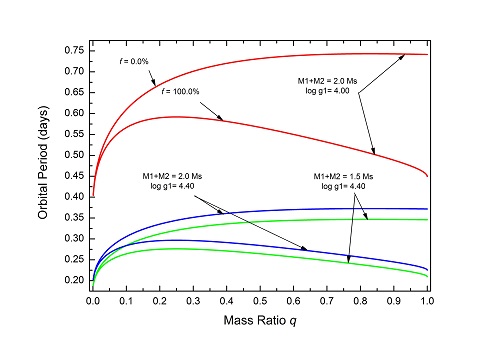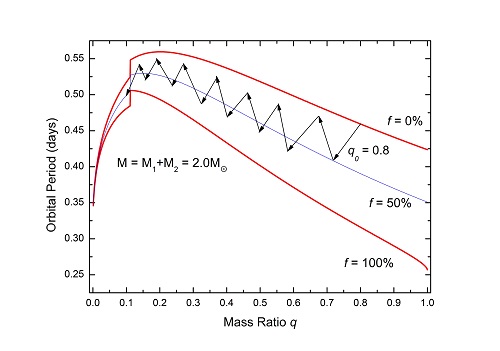Recently, a paper published by the journal MONTHLY NOTICES of the Royal Astronomical Society (MNRAS) has reported a new progress of Contact binaries. The work is achieved by LIU Liang et al., an associate research fellow of the binaries and variable stars group of the Yunnan Observatories, Chinese Academy of Sciences. In this work, LIU et al. found a high correlation between the orbital periods (P) and the fill-out factors (f) of contact binary systems. This correlation has been underestimated for a long time in previous studies. Based on this discovery, LIU et al. proposed an f-dominated mechanism for long-term period variations of contact binaries, which possibly reveals the other evolutionary track of contact binary systems.
Contact binaries are a kind of close binary system with very strong interaction. Because of its complicated structure and interaction, so far the formation, evolution and outcomes of contact binaries are still an unsolved difficulty. Long-term period variations imply the evolutionary state of contact binaries within the same time scale, which will determine their lifetime. It was believed that long-term period variations of contact binaries are dominated by their mass ratio q. Matter moves freely between the two components, which changes q and meanwhile changes P.
However, by the numerical method, LIU et al. found that the observed long-term variations of P could also be caused by changes of fill-out factor (f). They believed that mass transfer and mass loss both occur via the common convective envelope (CCE). Different physical conditions of two components could lead to a different mass transfer rate. Thus, some matter will stagnate in CCE. If this part of the matter can be hold in CCE, and can be released after a certain accumulation, a new evolutionary model called f-dominated model will be obtained.
In this new model, matter enters or leaves CCE periodically, transferring from one component to the other slowly. P and f should oscillate in whole process; meanwhile q continually decreases until the system merges. The f-dominated model is good to be applied to make an explanation for the presence of the extremely short period, high mass ratio and deep contact binaries. The study of LIU et al. reveals the complication of contact binary systems again, and indicates the importance of CCE in the evolution of contact binaries.
The reviewer has highly approved of this work. He has mentioned twice that the results are interesting and scientifically valuable. (……As I already stated in the previous review, I find the results interesting and scientifically valuable……)
This work is partly supported by the young academic and technology leaders project of Yunnan Province (No. 2015HB098), and by the Chinese Natural Science Foundation (No. U11773066).

Figure 1.The contact binary dynamical parameter map. The solid lines denote the relationship between q, P and f with constants M and log g1. The same color lines constitute a couple, which denotes a field from f = 0% to f = 100%. (Image by LIU Liang).

Figure 2. The contact binary dynamical evolution map. The solid lines are the same as the figure 1. In this figure, the log g1 is satisfied with the relationship of a main sequence stars. A contact binary system should be observed in the section limited by the red lines in its whole contact phase if the total mass is conservative. The black line with arrows is a suppositional evolutionary track of the contact binary (q0 = 0.8) with the total mass of two solar masses. The jumps of the red and blue lines are caused by the discontinuity of the M-R relationship. (Image by LIU Liang).
CONTACT:
LIU Liang
Binaries & Variables Group , Yunnan Observatories, CAS
liul@ynao.ac.cn
0871-67339079